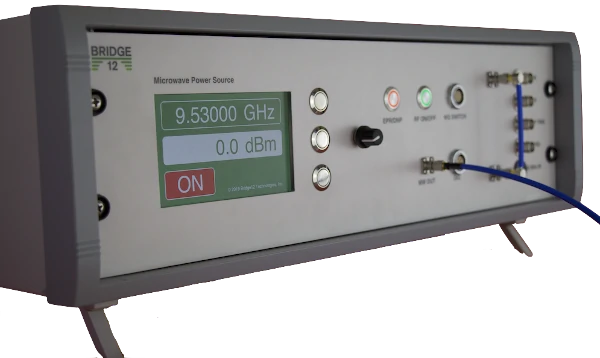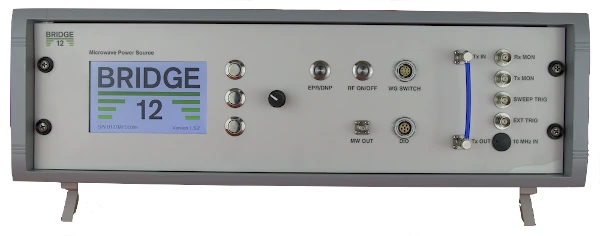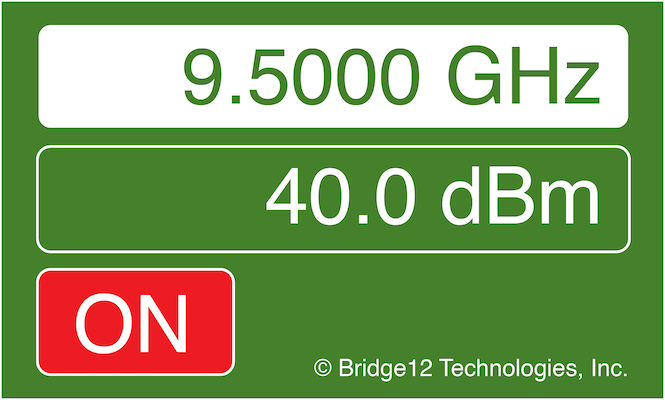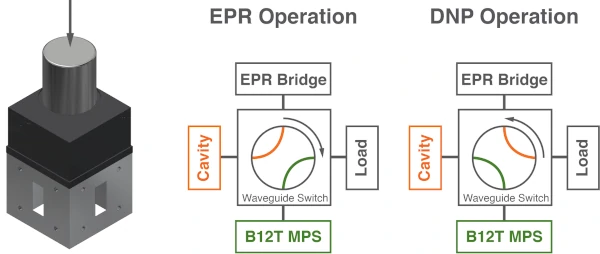
Upgrade your existing EPR Spectrometer
Unlike high-field DNP-enhanced solid- state NMR experiments, ODNP experiments at 9 GHz do not require a large superconducting NMR magnet or a high-power/high-frequency microwave source such as a gyrotron. In fact, any X-band EPR spectrometer can be easily upgraded with Bridge12 products for ODNP spectroscopy.

A Turn-Key Microwave Source
The Bridge12 MPS 9 GHz delivers up to 10 W of microwave power to the sample. The system features easy-to-use front panel operation and several failsafe features to protect your sample and your EPR instrumentation, such as the integrated power detector which monitors the forward and reflected microwave power. You don’t have to be an expert in microwave technology to operate this system. Instead of troubleshooting home-built instrumentation, keep focusing on your research.
Just Set the Frequency and Go
Simply set the correct microwave frequency and output power, enable the microwave output, and start recording ODNP-enhanced NMR spectra. For more advanced users, the system features an optional external trigger to modulate the microwave power directly from the NMR console, and a USB interface for deeper integration of the source into the target application.

Clear User Interface With Concise Documentation
The Bridge12 MPS features a clear, well-documented user interface. A large, five-inch front panel display is designed to show only the important values in an easy-to-read font size, even from a distance. Users can switch between the default screen and an advanced screen for more operation parameters.
Modular Platform With Add-Ons
The Bridge12 MPS has a modular design with a front panel SMA breakout foradding fast microwave switches or mixers for pulse shaping (e.g. AWG). Additional tuning/matching features can be added to display the cavity tuning in real time. Five additional digital input/output lines can be individually programmed for user-specific functions. For example, the instrument can be configured to run through a predefined power schedule, to fully automate ODNP experiments.

Connection Kit for Overhauser DNP (ODNP)
Bridge12 offers a connection kit for seamlessly integrating the ODNP microwave source and probe into existing EPR instrumentation. This allows a user to simply switch back and forth between EPR and DNP operation. The kit includes a waveguide switch that can be operated manually or automatically to ensure the safety of your EPR equipment.

Combine With NMR Spectrometer Controlled by OpenVnmrJ
The system can be equipped with a single-channel, compact NMR spectrometer. The system is entirely controlled using OpenVnmrJ. The Bridge12 MPS for ODNP-enhanced NMR spectroscopy is also available for experiments at K (24 GHz) and Q (35 GHz) band.
Technical Specifications
- Frequency Range: 8.5 – 11.5 GHz (also available for Q and K-band spectrometers)
- Maximum Output power: 5 or 10 W (cw). Continuous attenuation in steps of 0.01 dB
- Operation: Front Panel operation. Digital interface (USB) for remote operation (optional)
- TTL pulse modulation (optional): 100 ns minimum pulse length, 50 % minimum duty cycle (shorter pulses available).
- Temperature monitor and safety switch to prevent overheating of the amplifier.
- System size (W x H x D): 12 x 7 x 14 (inch), 30.5 x 17.8 x 35.6 (cm)
- System weight: 3.3 lbs (1.5 kg)
- Input power: 110 – 220 V (50/60 Hz)